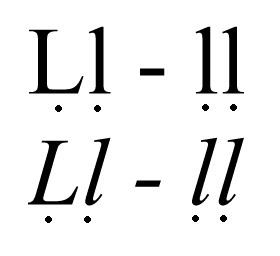Ḷ (minuscule: ḷ) is a letter of the Latin alphabet, derived from L with a diacritical dot below. It is or was used in some languages to represent various sounds.
In Asturian, two digraphs (Ḷḷ, minuscule: ḷḷ) are used to represent some western dialectal phonemes corresponding to standard ll (representing a palatal lateral approximant [ʎ]). Among this group of dialectal pronunciations, usually called che vaqueira, can appear basically: a voiced retroflex plosive [ɖ], a voiced retroflex affricate [dʐ], a voiceless retroflex affricate [tʂ] and a voiceless alveolar affricate [t͡s]. Formerly, this group of sounds were represented as lh (in Fernan Coronas's proposed writing system), ts or ŝ. However, this grapheme is used only in dialectal texts and in toponyms of western Asturias. Because of the difficulties of writing it in digital texts, non-diacritical l.l (majuscule: L.l) is also often used.In the International Alphabet of Sanskrit Transliteration, ḷ is used to represent vocalic /l/.

